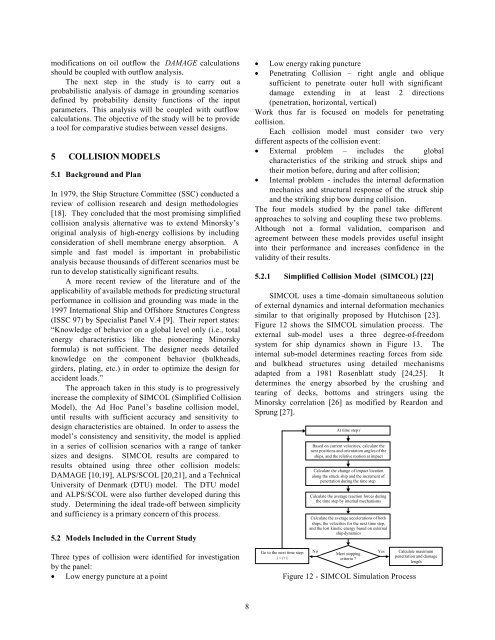Structural Design and Response in Collision and Grounding
Structural Design and Response in Collision and Grounding
Structural Design and Response in Collision and Grounding
Create successful ePaper yourself
Turn your PDF publications into a flip-book with our unique Google optimized e-Paper software.
modifications on oil outflow the DAMAGE calculationsshould be coupled with outflow analysis.The next step <strong>in</strong> the study is to carry out aprobabilistic analysis of damage <strong>in</strong> ground<strong>in</strong>g scenariosdef<strong>in</strong>ed by probability density functions of the <strong>in</strong>putparameters. This analysis will be coupled with outflowcalculations. The objective of the study will be to providea tool for comparative studies between vessel designs.5 COLLISION MODELS5.1 Background <strong>and</strong> PlanIn 1979, the Ship Structure Committee (SSC) conducted areview of collision research <strong>and</strong> design methodologies[18]. They concluded that the most promis<strong>in</strong>g simplifiedcollision analysis alternative was to extend M<strong>in</strong>orsky’sorig<strong>in</strong>al analysis of high-energy collisions by <strong>in</strong>clud<strong>in</strong>gconsideration of shell membrane energy absorption. Asimple <strong>and</strong> fast model is important <strong>in</strong> probabilisticanalysis because thous<strong>and</strong>s of different scenarios must berun to develop statistically significant results.A more recent review of the literature <strong>and</strong> of theapplicability of available methods for predict<strong>in</strong>g structuralperformance <strong>in</strong> collision <strong>and</strong> ground<strong>in</strong>g was made <strong>in</strong> the1997 International Ship <strong>and</strong> Offshore Structures Congress(ISSC 97) by Specialist Panel V.4 [9]. Their report states:“Knowledge of behavior on a global level only (i.e., totalenergy characteristics like the pioneer<strong>in</strong>g M<strong>in</strong>orskyformula) is not sufficient. The designer needs detailedknowledge on the component behavior (bulkheads,girders, plat<strong>in</strong>g, etc.) <strong>in</strong> order to optimize the design foraccident loads.”The approach taken <strong>in</strong> this study is to progressively<strong>in</strong>crease the complexity of SIMCOL (Simplified <strong>Collision</strong>Model), the Ad Hoc Panel’s basel<strong>in</strong>e collision model,until results with sufficient accuracy <strong>and</strong> sensitivity todesign characteristics are obta<strong>in</strong>ed. In order to assess themodel’s consistency <strong>and</strong> sensitivity, the model is applied<strong>in</strong> a series of collision scenarios with a range of tankersizes <strong>and</strong> designs. SIMCOL results are compared toresults obta<strong>in</strong>ed us<strong>in</strong>g three other collision models:DAMAGE [10,19], ALPS/SCOL [20,21], <strong>and</strong> a TechnicalUniversity of Denmark (DTU) model. The DTU model<strong>and</strong> ALPS/SCOL were also further developed dur<strong>in</strong>g thisstudy. Determ<strong>in</strong><strong>in</strong>g the ideal trade-off between simplicity<strong>and</strong> sufficiency is a primary concern of this process.5.2 Models Included <strong>in</strong> the Current StudyThree types of collision were identified for <strong>in</strong>vestigationby the panel:• Low energy puncture at a po<strong>in</strong>t• Low energy rak<strong>in</strong>g puncture• Penetrat<strong>in</strong>g <strong>Collision</strong> – right angle <strong>and</strong> obliquesufficient to penetrate outer hull with significantdamage extend<strong>in</strong>g <strong>in</strong> at least 2 directions(penetration, horizontal, vertical)Work thus far is focused on models for penetrat<strong>in</strong>gcollision.Each collision model must consider two verydifferent aspects of the collision event:• External problem – <strong>in</strong>cludes the globalcharacteristics of the strik<strong>in</strong>g <strong>and</strong> struck ships <strong>and</strong>their motion before, dur<strong>in</strong>g <strong>and</strong> after collision;• Internal problem - <strong>in</strong>cludes the <strong>in</strong>ternal deformationmechanics <strong>and</strong> structural response of the struck ship<strong>and</strong> the strik<strong>in</strong>g ship bow dur<strong>in</strong>g collision.The four models studied by the panel take differentapproaches to solv<strong>in</strong>g <strong>and</strong> coupl<strong>in</strong>g these two problems.Although not a formal validation, comparison <strong>and</strong>agreement between these models provides useful <strong>in</strong>sight<strong>in</strong>to their performance <strong>and</strong> <strong>in</strong>creases confidence <strong>in</strong> thevalidity of their results.5.2.1 Simplified <strong>Collision</strong> Model (SIMCOL) [22]SIMCOL uses a time -doma<strong>in</strong> simultaneous solutionof external dynamics <strong>and</strong> <strong>in</strong>ternal deformation mechanicssimilar to that orig<strong>in</strong>ally proposed by Hutchison [23].Figure 12 shows the SIMCOL simulation process. Theexternal sub-model uses a three degree-of-freedomsystem for ship dynamics shown <strong>in</strong> Figure 13. The<strong>in</strong>ternal sub-model determ<strong>in</strong>es react<strong>in</strong>g forces from side<strong>and</strong> bulkhead structures us<strong>in</strong>g detailed mechanismsadapted from a 1981 Rosenblatt study [24,25]. Itdeterm<strong>in</strong>es the energy absorbed by the crush<strong>in</strong>g <strong>and</strong>tear<strong>in</strong>g of decks, bottoms <strong>and</strong> str<strong>in</strong>gers us<strong>in</strong>g theM<strong>in</strong>orsky correlation [26] as modified by Reardon <strong>and</strong>Sprung [27].Go to the next time step:i = i+1At time step iBased on current velocities, calculate thenext positions <strong>and</strong> orientation angles of theships, <strong>and</strong> the relative motion at impactCalculate the change of impact locationalong the struck ship <strong>and</strong> the <strong>in</strong>crement ofpenetration dur<strong>in</strong>g the time stepCalculate the average reaction forces dur<strong>in</strong>gthe time step by <strong>in</strong>ternal mechanismsCalculate the average accelerations of bothships, the velocities for the next time step,<strong>and</strong> the lost k<strong>in</strong>etic energy based on externalship dynamicsNoMeet stopp<strong>in</strong>gcriteria ?YesCalculate maximumpenetration <strong>and</strong> damagelengthFigure 12 - SIMCOL Simulation Process8
















